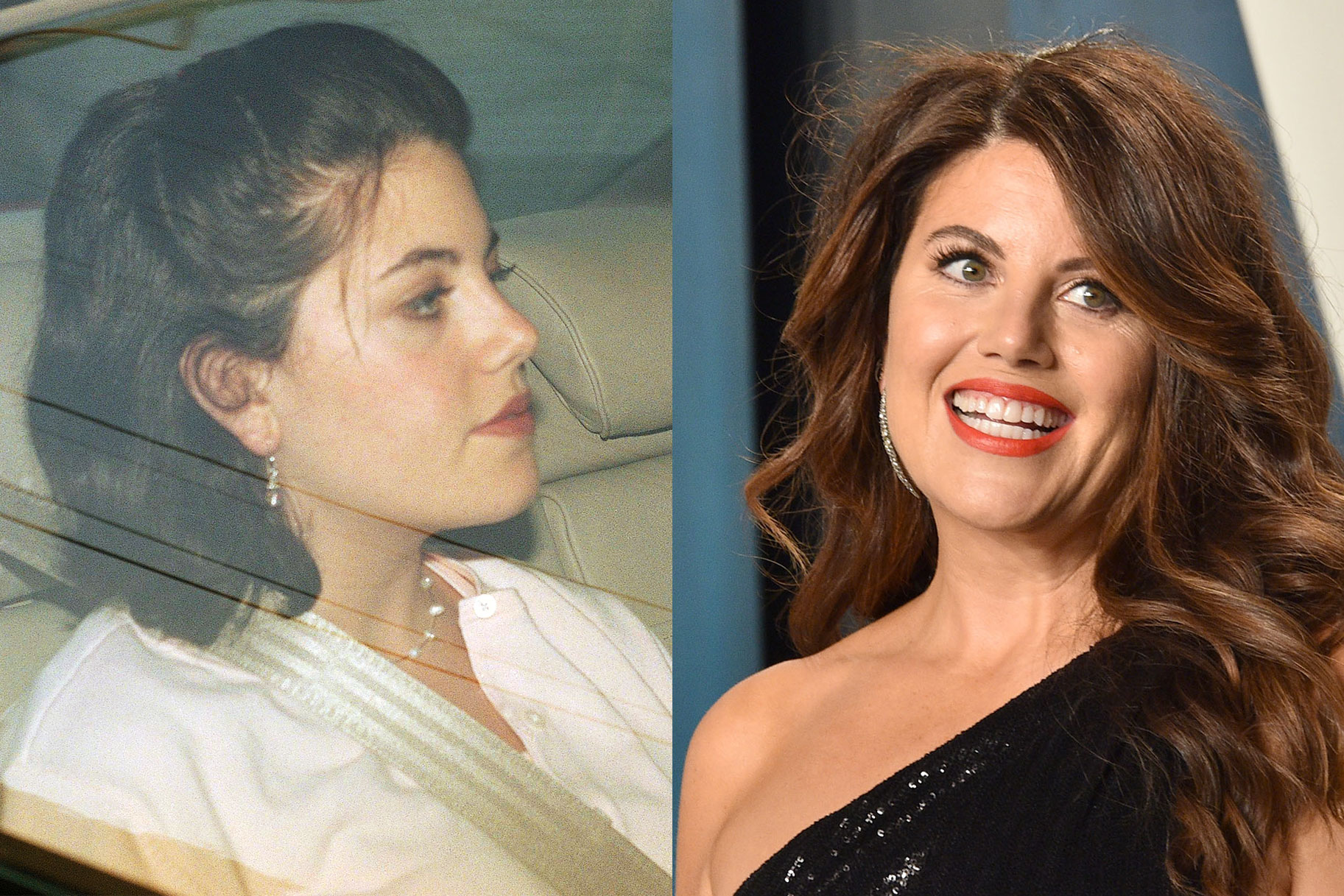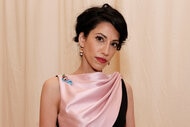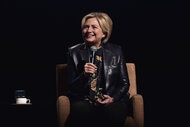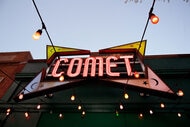Create a free profile to get unlimited access to exclusive videos, breaking news, sweepstakes, and more!
Where Is Monica Lewinsky, The Woman At The Center Of The Clinton Impeachment, Now?
Monica Lewinsky had just quit a low-level job in the Clinton Administration when prosecutors and the media upended her life.

In 1995 Monica Lewinsky was just another recent college graduate trying to figure out her next move career-wise. But over the next three years, she would become ensnared in one of the biggest scandals in the recent history of the United States. So what is she doing now?
The new Ryan Murphy limited series "Impeachment: American Crime Story," which debuts Sept. 7 on FX, looks back at Lewinsky's tumultuous years in Washington, D.C., her involvement with then-President Bill Clinton, a shocking betrayal by her supposed friend, Linda Tripp, and the legal, political and media fallout that followed.
Lewinsky, a Los Angeles native and graduate of Lewis & Clark College in Portland, Oregon, left the West Coast in June 1995 to take a White House internship that she obtained with the assistance of a large Democratic donor and friend of her mother's, according to the Washington Post.
In the staid, navy-blue-and-beige world of official Washington D.C., the extroverted then-22-year-old, who was first assigned to the office of Clinton's then-Chief of Staff Leon Panetta, reportedly stood out: the Post's January 1998 profile of her, relying heavily on interviews with her contemporaries, paints a picture of a young, extremely gregarious woman who people often accused of flirting or being inappropriately conversationally intimate with near-strangers. An article about their brief acquaintance in December and January 1997 by CNN anchor Jake Tapper, then a reporter for the Washington City Paper, confirms that accounting: he referred to her as "refreshing" compared to other D.C. career women and "nice," gregarious, self-deprecating and almost too open and optimistic. (He also found her a more fashion-forward dresser than much of D.C.)
She apparently stood out to the President Clinton as well: her internship in Panetta's office began in July 1995 and, after what Lewinsky would later characterize to investigators as months of "intense flirting" that began in August, she and Bill Clinton had their first intimate contact on Nov. 15, 1995. (She told the investigators that she indicated more interest by, during a moment in which the two were alone in Panetta's office, lifting her blazer to reveal the straps of her thong above her pants.)
In Dec. 1995, Lewinsky accepted a new, paid position in the White House Office of Legislative Affairs, handling the mail.
She and Clinton had a total of 10 sexual encounters — eight during her tenure at the White House and two thereafter — between Nov. 1995 and March 1997 — but they didn't meet in person between April and Dec. 1996.
Lewinsky testified that during that nine-month period, they engaged in sexual banter during private phone conversations. The timing coincided with Clinton's re-election campaign and Lewinsky's transfer to the Pentagon, to be an assistant to the spokesman. (White House staff testified that they arranged the transfer because her crush on the president was obvious.) Lewinsky, who turned 23 that July, met and befriended Linda Tripp, 46 — a former George H.W. Bush White House employee who herself had been transferred to the Pentagon by the Clinton White House — while at the Pentagon and confided in her about her affair with Clinton.
Clinton and Lewinsky's physical affair resumed a few months after the election in 1996, while she was at the Pentagon.
Lewinsky testified that their intimate encounters were limited to kissing, his manual stimulation of her (including, now infamously, with a cigar in March 1996) and her manual and oral stimulation of him. She also testified that it was not until their penultimate sexual encounter, in Feb. 1997 — during which she was wearing a navy blue Gap shirt dress — that he allowed himself to ejaculate.
(That dress would ultimately be subpoenaed by prosecutors and tested for Clinton's DNA after Lewinsky, who testified that she did not keep the dress as a souvenir but simply had a habit of not immediately cleaning her clothes, noticed much later that it was stained with something. She initially thought it might be spinach dip.)
They had what ended up being their final encounter on March 29, 1997. On May 24 — having, according to the Starr Report, heard gossip about their affair from the same people who had recommended Lewinsky for the internship — Clinton ended their relationship.
In the fall of 1997, Tripp began taping her conversations with Lewinsky. She began leaking them to reporters in October 1997, according to CNN.
In Dec. 1997, Clinton was required to provide answers under oath to written questions as part of a deposition in another case. He was asked "to identify all women who were state or federal employees and with whom he had had 'sexual relations’' since 1986," according to the Starr Report, and he answered that there weren't any.
On Jan. 7, 1998, Lewinsky and her lawyer filed an affidavit denying that she'd had an affair with Clinton.
Between Jan. 9 and Jan. 12, 1998, Linda Tripp gave the tapes of her conversations with Lewinsky to her lawyer and spoke of their existence to investigators, according to CNN. They wired her and sent her to a meeting with Lewinsky on Jan. 14, 1998, in which Lewinsky encouraged her to make false statements in her own affidavit.
On Jan. 16, 1998, Tripp lured Lewinsky to a meeting, where she was detained by the FBI, discouraged from calling a lawyer and threatened with more than two decades in jail as a result of her false affidavit, as recounted by Lewinsky in Vanity Fair in 2014. They offered her a deal for immunity in exchange for her testimony. (Her parents ultimately hired a lawyer, who advised her to wait to take the deal until after he could speak to her.)
On Jan. 17, 1998, Clinton was deposed in person and asked specifically about an affair with Lewinsky. He "denied that he had engaged in a 'sexual affair,' a 'sexual relationship,' or 'sexual relations' with Ms. Lewinsky," according to the Starr Report, which had been defined by lawyers in the investigation as "when the person knowingly engages in or causes — (1) contact with the genitalia, anus, groin, breast, inner thigh, or buttocks of any person with an intent to arouse or gratify the sexual desire of any person."
The Drudge Report first leaked the existence of Lewinsky and the alleged affair on Jan. 19, and the mainstream media broke the story on Jan. 21. Clinton denied the affair.
Lewinsky and her lawyer announced their intention to cooperate with investigators in exchange for immunity on Jan. 25, according to CNN. Clinton gave his infamous public address in which he said, "I did not have sexual relations with that woman," on Jan. 28.
After six months of legal wrangling, television mockery and inescapable headlines, Lewinsky, her lawyers and the investigators agreed to an immunity deal on July 28. On Aug. 3, Clinton was forced to give a blood sample to be compared to the DNA on the blue dress she turned over to the FBI (it was deemed a match.) She testified before a grand jury investigating Clinton on Aug. 6. about the extremely intimate details of their affair, all of which were included in the ultimate report presented to Congress.
Clinton testified on Aug. 17 and denied lying under oath, stating that "most ordinary Americans" would understand that any "sexual relationship" was defined solely by having intercourse with somebody. He refused to get specific about the nature of the intimate acts in which he and Lewinsky engaged, but stated that even the very granular definition of "sexual relationship" offered by lawyers in the deposition would not have covered what prosecutors were suggesting he did, because, as the person being asked the question, "the person who has oral sex performed on him, then the contact is with — not with anything on that list, but with the lips of another person."
Prosecutors, and eventually Congress, continued to contend that he lied.
Clinton gave a public address later that day and admitted to an inappropriate relationship with Lewinsky.
He was impeached by the House of Representatives on Dec. 19, 1998 for lying under oath and obstructing justice, but acquitted by the Senate on Feb. 12, 1999. Lewinsky was never asked to given public testimony in the case, though her words from her grand jury testimony were ultimately voiced in an audio book of the Starr report by a soap opera actress.
Lewinsky did not have an easy few years after the impeachment was over. Her legal bills ran into the millions. Job interviews, when she could arrange them, rarely resulted in offers, as she wrote in Vanity Fair. She tried to launch a line of handbags in 1999, which did not last, and — after she had repeatedly been written off as too chubby to be sexually attractive, all evidence to the contrary — briefly worked as a spokesperson for weight loss company Jenny Craig. She did television appearances, including a brief stint as a reality dating show host, many of which, she wrote in Vanity Fair, contributed to her ongoing feelings of shame.
In 2005, she moved to the U.K. to study at the London School of Economics, where she was finally allowed a modicum of anonymity. After graduating, by her account, she bounced around working on various projects attempting to make a life for herself.
In 2014, realizing that she was unlikely to survive a Hilary Clinton campaign for the presidency in relative obscurity, she began writing for Vanity Fair, and got involved in various anti-bullying campaigns. She gave a well-received TED Talk on bullying in 2015 and is a contributor to Mackenzie Bezos' anti-bullying campaign Bystander Revolution.
In 2018, producer Ryan Murphy publicly scrapped his plans to adapt (now-scandal-plagued) author and commentary Jeffrey Toobin's 2000 book on the Clinton impeachment for an "American Crime Story" season, telling the Hollywood Reporter that, instead, he turned to Lewinsky.
"'If you want to produce it with me, I would love that; but you should be the producer and you should make all the goddamn money,'" he told THR that he said to Lewinsky.
She took him up on the offer, and was reportedly very involved in shaping the character's lines and portrayal, according to Entertainment Weekly. The series focuses intensely on the misogyny that plagued the media coverage of the scandal, as well as the ways in which it impacted the women involved, according to Deadline.
And as for the blue dress? As her property that was evidence in a trial since concluded, it was returned to Lewinsky by prosecutors in 2001, according to USA Today. In Vanity Fair in 2014, she wrote, "It’s time to burn the beret and bury the blue dress," but there's no evidence what she actually did with either.

















